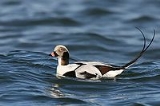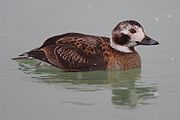
Long-tailed Duck
Encyclopedia
The Long-tailed Duck or Oldsquaw (Clangula hyemalis) is a medium-sized sea duck. It is the only living member of its genus
, Clangula; this was formerly used for the goldeneye
s, with the Long-tailed Duck being placed in Harelda. An undescribed congener is known from the Middle Miocene Sajóvölgyi Formation (Late Badenian, 13-12 mya) of Mátraszõlõs, Hungary
(Gál et al. 1998-99).
 Adults have white underparts, though the rest of the plumage
Adults have white underparts, though the rest of the plumage
goes through a complex moulting process. The male has a long pointed tail (10 to 15 cm) and a dark grey bill
crossed by a pink
band. In winter, the male has a dark cheek patch on a mainly white head and neck, a dark breast and mostly white body. In summer, the male is dark on the head, neck and back with a white cheek patch. The female has a brown back and a relatively short pointed tail. In winter, the female's head and neck are white with a dark crown. In summer, the head is dark. Juveniles resemble adult females in autumn plumage, though with a lighter, less distinct cheek patch.
Their breeding habitat is in tundra
pools and marshes, but also along sea coasts and in large mountain lakes in the North Atlantic region, Alaska
, northern Canada
, northern Europe
and Russia
. The nest
is located on the ground near water; it is built using vegetation and lined with down. They are migratory
and winter along the eastern and western coasts of North America, on the Great Lakes
, coastal northern Europe and Asia, with stragglers to the Black Sea
. The most important wintering area is the Baltic Sea
, where a total of about 4.5 million gather.
The Long-tailed Duck is gregarious, forming large flocks in winter and during migration. They feed by diving for mollusks, crustacean
s and some small fish
. Although they usually feed close to the surface, they are capable of diving to depths of 60m (200 feet).
In North American English
it is sometimes called Oldsquaw, though this name has fallen out of favour under influence of negative connotations of the word squaw
in English usage. Some biologists have also feared that this name would be offensive to some Native American tribes involved in the conservation effort. The American Ornithologists' Union (2000) stated that "political correctness
" was not sufficient to change the name, but "to conform with English usage in other parts of the world", it officially adopted the name Long-tailed Duck.
The males are vocal and have a musical yodelling call Ow, ow, owal-ow.
The Long-tailed Duck is one of the species to which the Agreement on the Conservation of African-Eurasian Migratory Waterbirds (AEWA
) applies.
Genus
In biology, a genus is a low-level taxonomic rank used in the biological classification of living and fossil organisms, which is an example of definition by genus and differentia...
, Clangula; this was formerly used for the goldeneye
Goldeneye (duck)
Goldeneye are small tree-hole nesting northern hemisphere seaducks belonging to the genus Bucephala. Their plumage is black and white, and they eat fish, crustaceans and other marine life....
s, with the Long-tailed Duck being placed in Harelda. An undescribed congener is known from the Middle Miocene Sajóvölgyi Formation (Late Badenian, 13-12 mya) of Mátraszõlõs, Hungary
Hungary
Hungary , officially the Republic of Hungary , is a landlocked country in Central Europe. It is situated in the Carpathian Basin and is bordered by Slovakia to the north, Ukraine and Romania to the east, Serbia and Croatia to the south, Slovenia to the southwest and Austria to the west. The...
(Gál et al. 1998-99).
Description

Plumage
Plumage refers both to the layer of feathers that cover a bird and the pattern, colour, and arrangement of those feathers. The pattern and colours of plumage vary between species and subspecies and can also vary between different age classes, sexes, and season. Within species there can also be a...
goes through a complex moulting process. The male has a long pointed tail (10 to 15 cm) and a dark grey bill
Beak
The beak, bill or rostrum is an external anatomical structure of birds which is used for eating and for grooming, manipulating objects, killing prey, fighting, probing for food, courtship and feeding young...
crossed by a pink
Pink
Pink is a mixture of red and white. Commonly used for Valentine's Day and Easter, pink is sometimes referred to as "the color of love." The use of the word for the color known today as pink was first recorded in the late 17th century....
band. In winter, the male has a dark cheek patch on a mainly white head and neck, a dark breast and mostly white body. In summer, the male is dark on the head, neck and back with a white cheek patch. The female has a brown back and a relatively short pointed tail. In winter, the female's head and neck are white with a dark crown. In summer, the head is dark. Juveniles resemble adult females in autumn plumage, though with a lighter, less distinct cheek patch.
Their breeding habitat is in tundra
Tundra
In physical geography, tundra is a biome where the tree growth is hindered by low temperatures and short growing seasons. The term tundra comes through Russian тундра from the Kildin Sami word tūndâr "uplands," "treeless mountain tract." There are three types of tundra: Arctic tundra, alpine...
pools and marshes, but also along sea coasts and in large mountain lakes in the North Atlantic region, Alaska
Alaska
Alaska is the largest state in the United States by area. It is situated in the northwest extremity of the North American continent, with Canada to the east, the Arctic Ocean to the north, and the Pacific Ocean to the west and south, with Russia further west across the Bering Strait...
, northern Canada
Canada
Canada is a North American country consisting of ten provinces and three territories. Located in the northern part of the continent, it extends from the Atlantic Ocean in the east to the Pacific Ocean in the west, and northward into the Arctic Ocean...
, northern Europe
Europe
Europe is, by convention, one of the world's seven continents. Comprising the westernmost peninsula of Eurasia, Europe is generally 'divided' from Asia to its east by the watershed divides of the Ural and Caucasus Mountains, the Ural River, the Caspian and Black Seas, and the waterways connecting...
and Russia
Russia
Russia or , officially known as both Russia and the Russian Federation , is a country in northern Eurasia. It is a federal semi-presidential republic, comprising 83 federal subjects...
. The nest
Bird nest
A bird nest is the spot in which a bird lays and incubates its eggs and raises its young. Although the term popularly refers to a specific structure made by the bird itself—such as the grassy cup nest of the American Robin or Eurasian Blackbird, or the elaborately woven hanging nest of the...
is located on the ground near water; it is built using vegetation and lined with down. They are migratory
Bird migration
Bird migration is the regular seasonal journey undertaken by many species of birds. Bird movements include those made in response to changes in food availability, habitat or weather. Sometimes, journeys are not termed "true migration" because they are irregular or in only one direction...
and winter along the eastern and western coasts of North America, on the Great Lakes
Great Lakes
The Great Lakes are a collection of freshwater lakes located in northeastern North America, on the Canada – United States border. Consisting of Lakes Superior, Michigan, Huron, Erie, and Ontario, they form the largest group of freshwater lakes on Earth by total surface, coming in second by volume...
, coastal northern Europe and Asia, with stragglers to the Black Sea
Black Sea
The Black Sea is bounded by Europe, Anatolia and the Caucasus and is ultimately connected to the Atlantic Ocean via the Mediterranean and the Aegean seas and various straits. The Bosphorus strait connects it to the Sea of Marmara, and the strait of the Dardanelles connects that sea to the Aegean...
. The most important wintering area is the Baltic Sea
Baltic Sea
The Baltic Sea is a brackish mediterranean sea located in Northern Europe, from 53°N to 66°N latitude and from 20°E to 26°E longitude. It is bounded by the Scandinavian Peninsula, the mainland of Europe, and the Danish islands. It drains into the Kattegat by way of the Øresund, the Great Belt and...
, where a total of about 4.5 million gather.
The Long-tailed Duck is gregarious, forming large flocks in winter and during migration. They feed by diving for mollusks, crustacean
Crustacean
Crustaceans form a very large group of arthropods, usually treated as a subphylum, which includes such familiar animals as crabs, lobsters, crayfish, shrimp, krill and barnacles. The 50,000 described species range in size from Stygotantulus stocki at , to the Japanese spider crab with a leg span...
s and some small fish
Fish
Fish are a paraphyletic group of organisms that consist of all gill-bearing aquatic vertebrate animals that lack limbs with digits. Included in this definition are the living hagfish, lampreys, and cartilaginous and bony fish, as well as various extinct related groups...
. Although they usually feed close to the surface, they are capable of diving to depths of 60m (200 feet).
In North American English
North American English
North American English is the variety of the English language of North America, including that of the United States and Canada. Because of their shared histories and the similarities between the pronunciation, vocabulary and accent of American English and Canadian English, the two spoken languages...
it is sometimes called Oldsquaw, though this name has fallen out of favour under influence of negative connotations of the word squaw
Squaw
Squaw is an English language loan-word, used as a noun or adjective, whose present meaning is an indigenous woman of North America. It is derived from the eastern Algonquian morpheme meaning 'woman' that appears in numerous Algonquian languages variously spelled squa, skwa, esqua, sqeh, skwe, que,...
in English usage. Some biologists have also feared that this name would be offensive to some Native American tribes involved in the conservation effort. The American Ornithologists' Union (2000) stated that "political correctness
Political correctness
Political correctness is a term which denotes language, ideas, policies, and behavior seen as seeking to minimize social and institutional offense in occupational, gender, racial, cultural, sexual orientation, certain other religions, beliefs or ideologies, disability, and age-related contexts,...
" was not sufficient to change the name, but "to conform with English usage in other parts of the world", it officially adopted the name Long-tailed Duck.
The males are vocal and have a musical yodelling call Ow, ow, owal-ow.
The Long-tailed Duck is one of the species to which the Agreement on the Conservation of African-Eurasian Migratory Waterbirds (AEWA
AEWA
The Agreement on the Conservation of African-Eurasian Migratory Waterbirds is the largest of its kind developed so far under the Bonn Convention. It was concluded on 16 June 1995 at The Hague, the Netherlands and entered into force on 1 November 1999 after the required number of at least fourteen...
) applies.
External links
- Long-tailed Duck videos, photos & sounds on the Internet Bird Collection

